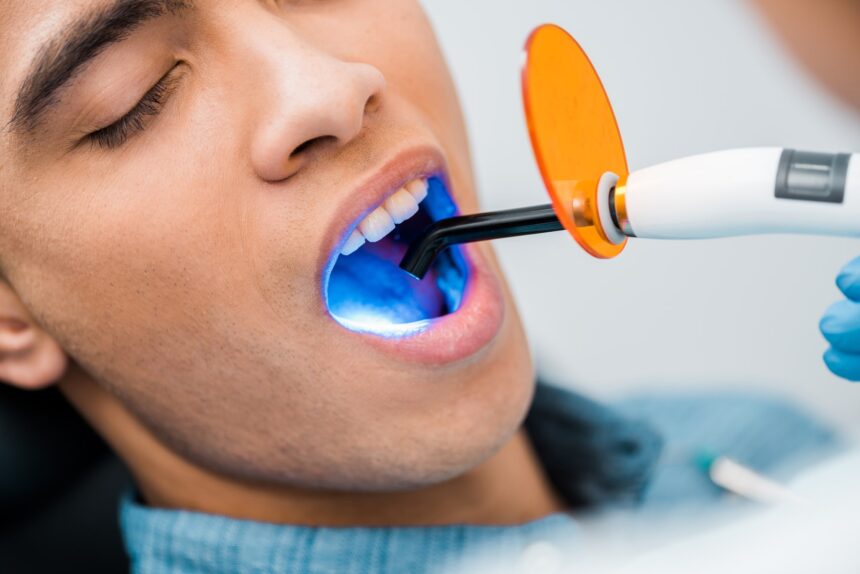Modern dentistry is evolving rapidly, and one of the most exciting advancements is laser dentistry. By combining precision technology with patient comfort, laser-based dental treatments are transforming how dentists diagnose and treat oral problems. From pain-free cavity fillings to faster healing times, laser dentistry is reshaping the future of oral care.
What Is Laser Dentistry?
Laser dentistry uses focused light energy (laser beams) to perform a wide range of dental procedures with minimal discomfort. The word “laser” stands for Light Amplification by Stimulated Emission of Radiation, and it allows dentists to target specific tissues with high precision.
Dentists can use lasers on both hard tissues (teeth and bone) and soft tissues (gums, tongue, and inner cheeks) for various treatments, including cavity removal, gum reshaping, and teeth whitening.
How Laser Dentistry Works
In laser dentistry, a concentrated beam of light interacts with oral tissues to remove, reshape, or sterilize affected areas.
Depending on the wavelength and energy used, lasers can cut, vaporize, or harden tissue — all with exceptional accuracy.
There are two main types of lasers used in dentistry:
| Type of Laser | Application |
|---|---|
| Hard Tissue Lasers | Used for teeth — removing decay, preparing cavities, and sealing enamel. |
| Soft Tissue Lasers | Used for gums — reshaping, cutting, or healing soft tissues with minimal bleeding. |
These lasers minimize the need for drills or scalpels, offering a far more comfortable experience for patients.
Key Benefits of Laser Dentistry
1. Minimized Pain and Discomfort
Traditional dental tools like drills can cause vibrations and heat, leading to discomfort. Laser treatments, however, are nearly pain-free, often eliminating the need for anesthesia.
2. Less Bleeding and Swelling
Lasers cauterize as they cut, which seals blood vessels immediately. This means minimal bleeding, swelling, and faster recovery times after procedures.
3. Greater Precision and Accuracy
Laser beams can precisely target diseased tissue without harming healthy areas. This accuracy is especially beneficial for delicate gum surgeries and cavity preparations.
4. Reduced Risk of Infection
Because lasers sterilize the treated area, there’s a lower chance of bacterial infections, making them ideal for surgical and restorative procedures.
5. Faster Healing and Recovery
Patients treated with lasers often experience faster healing, less postoperative pain, and shorter recovery periods compared to traditional methods.
6. Anxiety-Free Experience
For patients who fear drills and needles, laser dentistry offers a quiet, vibration-free alternative that reduces dental anxiety significantly.
Common Dental Procedures Using Laser Technology
Laser technology has a wide range of dental applications, both in restorative and cosmetic dentistry.
1. Cavity Detection and Removal
Lasers can detect tooth decay in its earliest stages, allowing for preventive treatment before cavities worsen. They can also precisely remove decay while preserving more of the healthy tooth structure.
2. Gum Disease Treatment
In cases of gum infection or periodontitis, lasers can remove bacteria and infected tissue with high precision, promoting natural healing and regeneration.
3. Teeth Whitening
Laser-assisted teeth whitening accelerates the bleaching process, providing brighter results in less time. The heat generated by the laser enhances the effectiveness of whitening gels.
4. Gum Reshaping and Contouring
Soft tissue lasers are perfect for cosmetic gum reshaping — correcting a “gummy smile” or uneven gum lines for better aesthetics.
5. Frenectomy and Tongue-Tie Correction
In both adults and children, lasers can perform quick, blood-free corrections of tongue-tie (ankyloglossia) and lip-tie conditions, improving speech and feeding.
6. Biopsies and Lesion Removal
Dentists use lasers to remove small tissue samples for biopsies or eliminate benign mouth lesions with minimal pain and no sutures required.
7. Root Canal Disinfection
Laser energy can be used to disinfect root canals more effectively than traditional techniques, reducing the risk of reinfection.
How Laser Dentistry Improves Patient Experience
Laser technology has revolutionized not just treatments, but also how patients feel during and after their dental visits.
| Traditional Dentistry | Laser Dentistry |
|---|---|
| Requires drills and scalpels | Uses precise light energy |
| Often needs anesthesia | Usually pain-free |
| Bleeding and swelling common | Minimal bleeding and faster healing |
| Longer recovery time | Shorter and smoother recovery |
| Loud and uncomfortable | Quiet and gentle |
The result is a more comfortable, efficient, and patient-friendly experience that encourages better dental care compliance.
Are There Any Risks or Limitations?
While laser dentistry offers many benefits, it’s not suitable for every case. For example:
- Lasers can’t remove metal fillings or restore large cavities.
- The procedure cost may be slightly higher due to advanced equipment.
- Not all dentists are trained or certified in laser treatments.
However, when performed by a skilled professional, laser dentistry is safe, effective, and approved by dental associations worldwide.
The Future of Laser Dentistry
With ongoing advancements in dental technology, the future of laser dentistry looks promising.
Emerging innovations are expected to:
- Improve precision for complex oral surgeries
- Enhance pain management and recovery outcomes
- Integrate with AI for diagnostic accuracy
Soon, laser-assisted procedures may become the standard in modern dental care, reducing the reliance on traditional tools and expanding treatment possibilities.
Conclusion
Laser dentistry is transforming the dental field with precision, comfort, and efficiency. By minimizing pain, reducing infection risks, and speeding up recovery, laser technology has made dental visits more patient-friendly than ever before. As innovation continues, laser-based treatments will likely become a core part of everyday dentistry, redefining oral health care for the modern world.
FAQs
1. Is laser dentistry safe?
Yes. Laser dentistry is approved by major dental associations and is considered safe when performed by trained professionals.
2. Does laser dentistry hurt?
Most patients report little to no pain. In many cases, anesthesia isn’t even needed.
3. Can lasers replace dental drills completely?
Not yet — while lasers handle many treatments, drills are still used for certain restorative procedures.
4. How long does it take to recover after laser treatment?
Recovery is generally faster than traditional methods, with minimal swelling or discomfort.
5. Is laser dentistry expensive?
The cost can be slightly higher due to advanced technology, but many patients find the comfort and faster healing well worth it.





